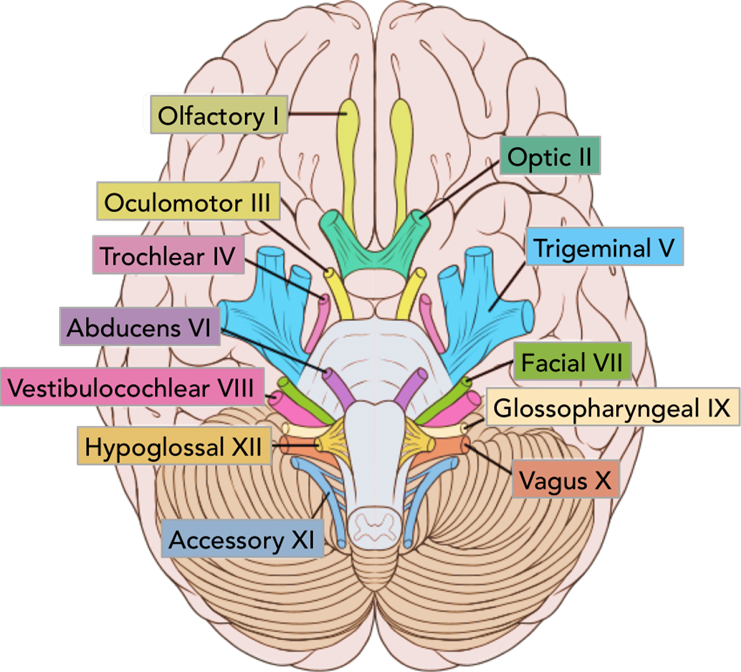A nurse is assessing a client’s cranial nerves. Which methods should the nurse use to assess cranial nerve V?
Ask the client to clench their teeth and assess facial sensation.
Ask the client to identify scented aromas.
Ask the client to read a Snellen chart.
Ask the client to raise his eyebrows.
The Correct Answer is A
Choice A Reason:
Cranial nerve V is the trigeminal nerve, which has both motor and sensory functions: Motor function: The nurse can assess this by asking the client to clench their teeth while palpating the masseter and temporalis muscles for strength. Sensory function: The nurse can assess this by lightly touching the client's face in different areas (forehead, cheeks, and jaw) with a cotton ball or sharp/dull object to check for sensation.
Choice B Reason:
Asking the client to identify scented aromas is a method used to assess cranial nerve I (Olfactory), not cranial nerve V. Cranial nerve V (Trigeminal) is assessed by testing facial sensation and motor functions such as chewing.

Choice C Reason:
Asking the client to read a Snellen chart is a method used to assess cranial nerve II (Optic), which is responsible for vision. This method does not assess cranial nerve V
Choice D Reason:
Asking the client to raise his eyebrows is a method used to assess cranial nerve VII (Facial), which controls facial expressions. This method is not used to assess cranial nerve V.
Nursing Test Bank
Naxlex Comprehensive Predictor Exams
Related Questions
Correct Answer is D
Explanation
Choice A reason: Encouraging coughing and deep breathing is important for postoperative care to prevent complications such as atelectasis and pneumonia. However, with an oxygen saturation of 85%, the immediate priority is to address the client’s hypoxemia. Once oxygen levels are stabilized, coughing and deep breathing exercises can be encouraged.
Choice B reason: Elevating the client to a high Fowler’s position can help improve lung expansion and ease breathing. While this is a beneficial intervention, it is not the first priority when the client’s oxygen saturation is critically low. Administering oxygen should be the initial step to quickly improve oxygenation.
Choice C reason: Administering prescribed analgesic medication is essential for managing the client’s pain, which can also help improve breathing patterns. However, pain management should follow the immediate correction of hypoxemia. Ensuring adequate oxygenation takes precedence over pain relief in this scenario.
Choice D reason: Administering oxygen at 2 L/min is the first action the nurse should take. With an oxygen saturation of 85%, the client is experiencing significant hypoxemia, which needs to be corrected promptly to prevent further complications. Oxygen therapy will help increase the oxygen levels in the blood and improve the client’s overall condition.
Correct Answer is A
Explanation
Choice A reason: Holding the cane on the opposite side of the weaker leg is the correct technique. For a client with left-sided weakness, holding the cane on the right side provides better support and balance. This method helps distribute weight away from the weaker side and reduces the risk of falls. The cane should be moved simultaneously with the weaker leg to maintain stability.

Choice B reason: Advancing the right leg and the cane together is incorrect. The correct technique involves moving the cane and the weaker leg (left leg in this case) together. This coordination helps in maintaining balance and provides the necessary support to the weaker side. Moving the stronger leg and the cane together does not offer the same level of support.
Choice C reason: Removing the rubber tip when using the cane is not advisable. The rubber tip provides traction and prevents the cane from slipping on various surfaces. Removing it would increase the risk of falls and injuries. The rubber tip is an essential safety feature of the cane.
Choice D reason: Placing the cane approximately 61 cm (24 inches) in front of the foot is too far. The cane should be placed about 15-20 cm (6-8 inches) in front of the foot to ensure stability and ease of movement. Placing the cane too far ahead can cause instability and make walking more difficult.
Whether you are a student looking to ace your exams or a practicing nurse seeking to enhance your expertise , our nursing education contents will empower you with the confidence and competence to make a difference in the lives of patients and become a respected leader in the healthcare field.
Visit Naxlex, invest in your future and unlock endless possibilities with our unparalleled nursing education contents today
Report Wrong Answer on the Current Question
Do you disagree with the answer? If yes, what is your expected answer? Explain.
Kindly be descriptive with the issue you are facing.
